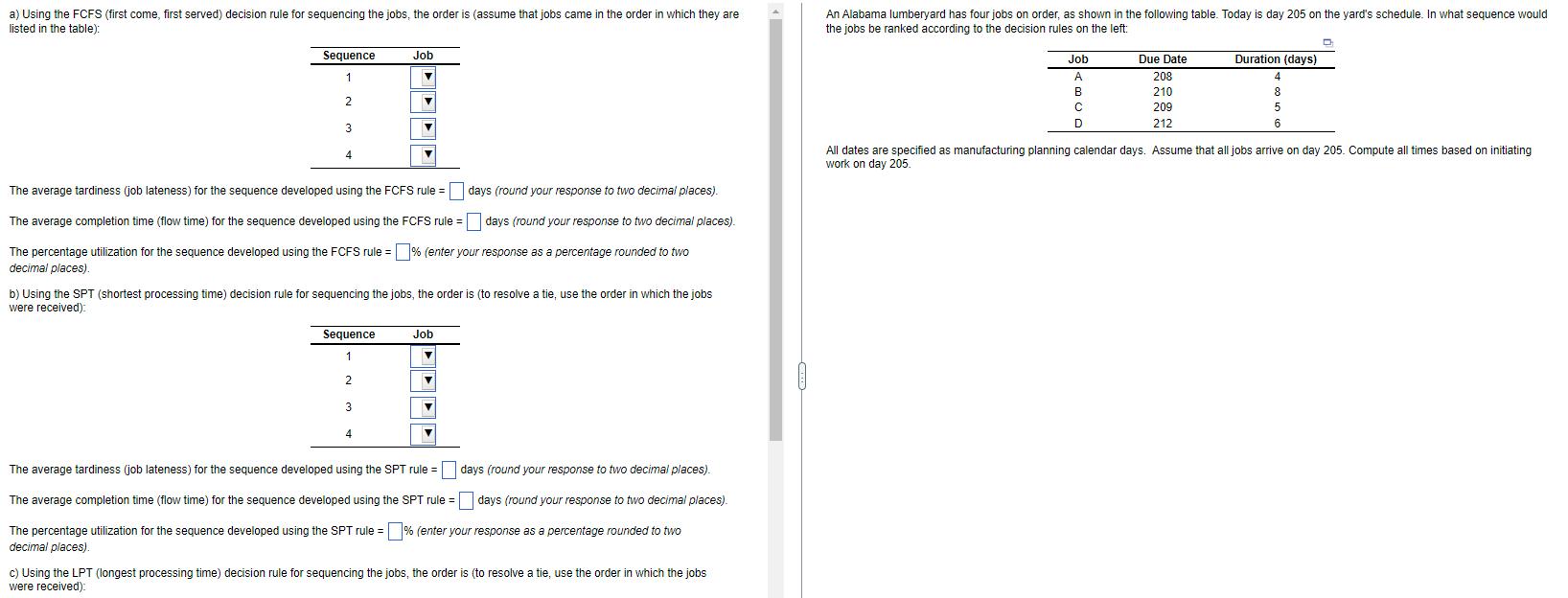a) Using the FCFS (first come, first served) decision rule for sequencing the jobs, the order is (assume that jobs came in the order


a) Using the FCFS (first come, first served) decision rule for sequencing the jobs, the order is (assume that jobs came in the order in which they are listed in the table): Sequence 1 2 3 4 Sequence 1 2 Job 3 The average tardiness (job lateness) for the sequence developed using the FCFS rule = days (round your response to two decimal places). The average completion time (flow time) for the sequence developed using the FCFS rule=days (round your response to two decimal places). The percentage utilization for the sequence developed using the FCFS rule=% (enter your response as a percentage rounded to two decimal places). 4 b) Using the SPT (shortest processing time) decision rule for sequencing the jobs, the order is (to resolve a tie, use the order in which the jobs were received): Job The average tardiness (job lateness) for the sequence developed using the SPT rule=days (round your response to two decimal places). The average completion time (flow time) for the sequence developed using the SPT rule=days (round your response to two decimal places). The percentage utilization for the sequence developed using the SPT rule=% (enter your response as a percentage rounded to two decimal places). c) Using the LPT (longest processing time) decision rule for sequencing the jobs, the order is (to resolve a tie, use the order in which the jobs were received): * An Alabama lumberyard has four jobs on order, as shown in the following table. Today is day 205 on the yard's schedule. In what sequence would the jobs be ranked according to the decision rules on the left: Job A B C D Due Date 208 210 209 212 Duration (days) 4 8 5 6 All dates are specified as manufacturing planning calendar days. Assume that all jobs arrive on day 205. Compute all times based on initiating work on day 205. Sequence 1 2 3 The average tardiness (job lateness) for the sequence developed using the LPT rule= days (round your response to two decimal places). The average completion time (flow time) for the sequence developed using the LPT rule= days (round your response to two decimal places). The percentage utilization for the sequence developed using the LPT rule=% (enter your response as a percentage rounded to two decimal places). d) Using the EDD (earliest due date) decision rule for sequencing the jobs, the order is (to resolve a tie, use the order in which the jobs were received): Sequence Job 1 2 3 4 The average tardiness (job lateness) for the sequence developed using the EDD rule=days (round your response to two decimal places). The average completion time (flow time) for the sequence developed using the EDD rule=days (round your response to two decimal places). The percentage utilization for the sequence developed using the EDD rule=% (enter your response as a percentage rounded to two decimal places). e) Using the Critical Ratio (CR) scheduling rule for sequencing the jobs, the order is: Job Sequence 1 2 Job 3 4 The average tardiness (job lateness) for the sequence developed using the CR rule= The average completion time (flow time) for the sequence developed using the CR rule = The percentage utilization for the sequence developed using the CR rule=% (enter your response as a percentage rounded to two decimal places). days (round your response to two decimal places). days (round your response to two decimal places).
Step by Step Solution
3.33 Rating (153 Votes )
There are 3 Steps involved in it
Step: 1
SOLUTION To determine the sequence of jobs and calculate the corresponding performance measures based on different decision rules lets analyze each rule one by one a FCFS FirstCome FirstServed Rule Th...
See step-by-step solutions with expert insights and AI powered tools for academic success
Step: 2

Step: 3

Ace Your Homework with AI
Get the answers you need in no time with our AI-driven, step-by-step assistance
Get Started


